eCommerce
11 Types of eCommerce Business Models and Classifications
Comparing shopping now and 10 years ago, it’s obvious that eCommerce has redefined and changed how we shop today. No one knows about online shopping; all types of eCommerce business models are anticipated to rise by 385% this decade.
It is now simpler than ever for creative entrepreneurs to turn their ideas into reality. While many tools and technologies are new and quickly evolving, the rules remain constant. You must understand your business model and specify how you will innovate to defy expectations.
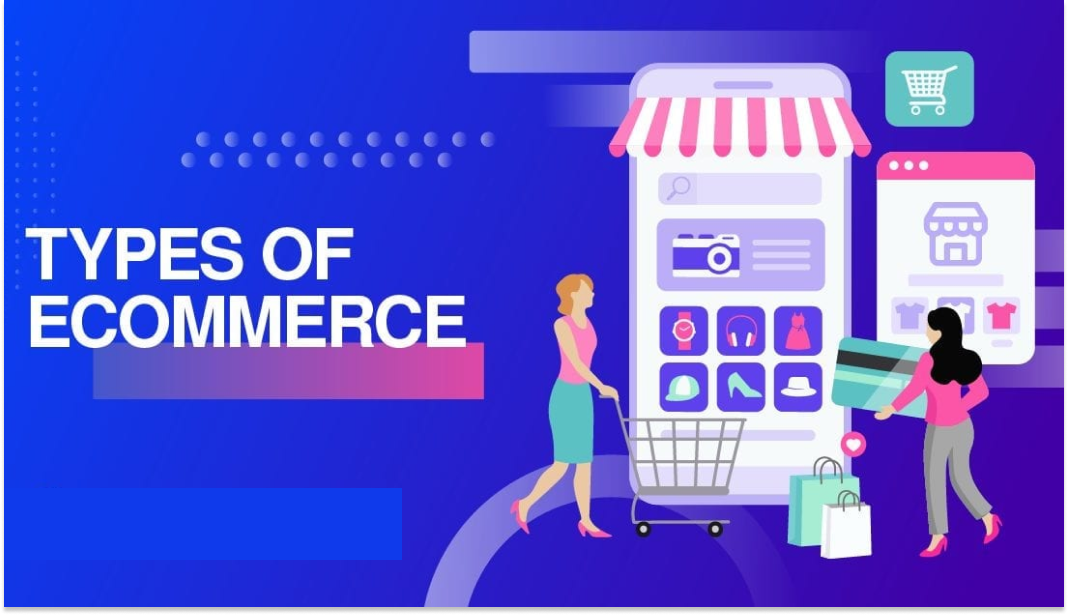
Table of Contents
Five Types of eCommerce Business Revenue Models
1. Dropshipping
Potential products are sourced from a manufacturer and sold at a commission by the ‘retailer,’ who never handles the product or holds any inventory. Once they have created their e-commerce store, they can add a wide selection of goods from different distributors with no financial commitment on their part.
The low barriers to entry lead to an over-saturation in many markets, with slim profit margins and low-quality products the reality. Shopify and AliExpress have made it possible to open your own e-commerce business in just a few hours. However, it takes time, networking and some exclusivity with your supplier to make drop shipping a truly profitable venture.
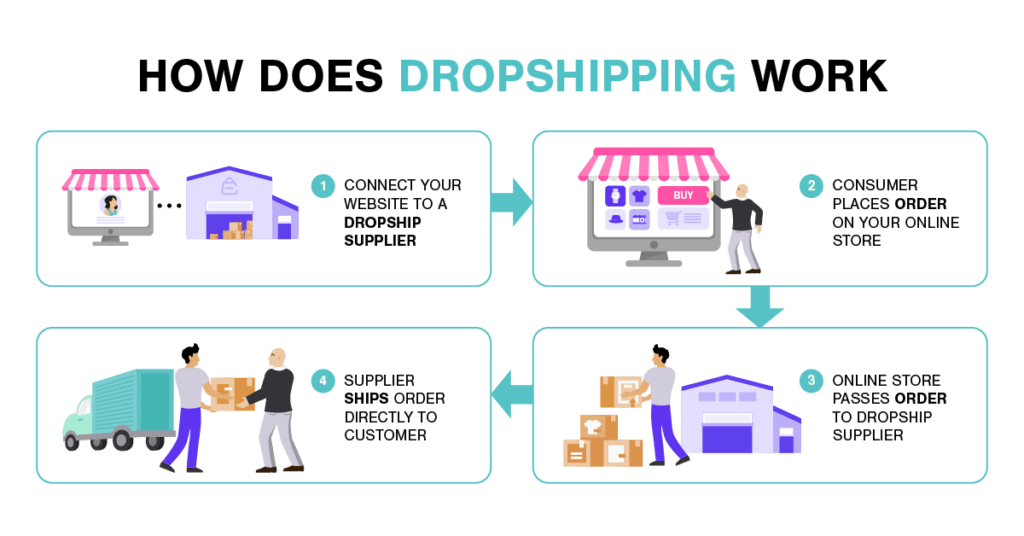
2. Wholesaling and warehousing
Wholesaling and warehousing e-commerce businesses require a lot of investment at the start—you need to manage inventory and stock, keep track of customer orders and shipping information, and invest in the warehouse space itself.
DollarDays.com is an online wholesaler with a huge product inventory of over 260,000 items. They use a crucial strategy for merchants in this space: sell to the general public and retailers by offering case and component pricing. This allows them to earn a greater profit margin than if they only sold wholesale.
- Wholesalers’ Solutions
It’s all about volume in the wholesale industry. You must send items to eBay, Amazon, Google, and other sites. All of this is included in BigCommerce’s $29 monthly Basic plan. There’s no need for fiddling. You can utilize X-Cart if you know how to code.
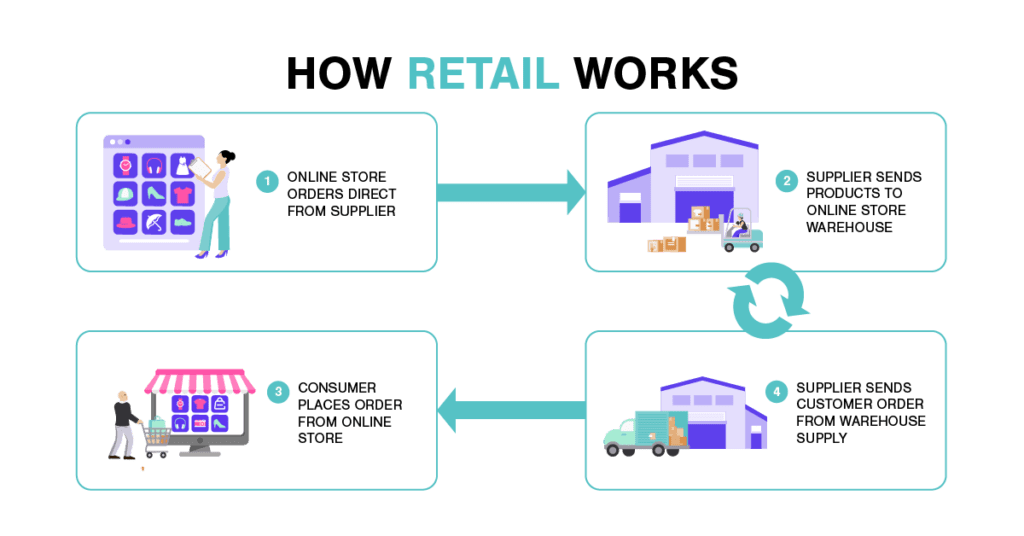
3. White label and private label
The perfect approach for a new eCommerce business that lacks the financial clout to manufacture its own product. Instead, the product is produced by a third party and the vendor then white labels it with their own brand, which they must focus on building and marketing.
Print On Demand is a typical kind of white labeling.
This strategy can be applied to any traditional business model, but it has risks. Once a manufacturer is chosen and the product is made, the business is committed to the stock, which means it will need to be very confident that it can ensure high standards are maintained by its manufacturer.
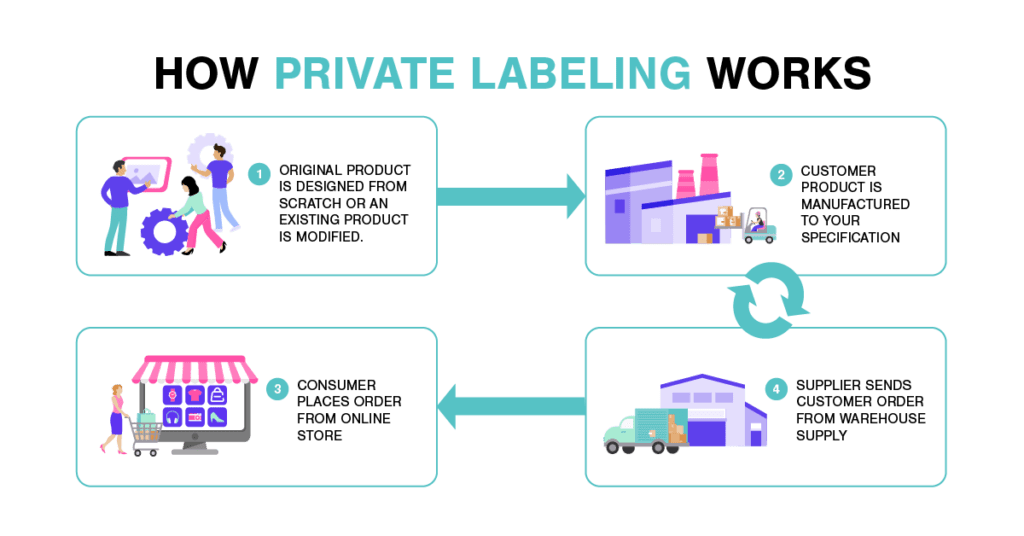
4. Subscription
Publishing houses in England employed a subscription strategy to send books to their devoted consumers as early as the 1600s. Thanks to eCommerce, businesses are moving beyond books and magazines.
Subscription services are now available in almost every sector to provide clients with convenience and savings. The Dollar Shave Club is one of the most well-known and profitable pure ecommerce companies. Stitch Fix, Blue Apron, and Nature Box are examples of subscription services.
- Online billing software with recurring payments
The concept of a subscription-based e-commerce business appeals to me. For subscription-based e-commerce, both Shopify and BigCommerce require extra, paid apps. To accomplish this, you’ll need something like WooCommerce Subscriptions (WordPress) or X-Cart.
5. D2C – Direct-to-Consumer
A new breed of consumer companies has established devoted followings with quick development by bypassing the intermediary. Vertical disruption has been established by online retailers like Warby Parker and Casper, but companies like Glossier are demonstrating how D2C can continue to be a source of innovation and development.
How to choose and start your eCommerce business model
Let’s pay attention to how the top business models operate in practice and the different types of eCommerce business models they employ to take an idea from conception.Honesty and investigation are essential in this situation. Spend time studying the market you’re targeting and being open about the unique value you can offer.
1. Identify your customers
Who do you want to serve? Which audience can you bring the most value to? Based on which direction the business is facing, you can choose the most appropriate type of eCommerce classifications among B2C, B2B, C2C, C2C or Government/ Public Administration eCommerce.
2. Choose your products
Different models will serve you better than others depending on your goods.If you’re making your own items, for example, you might want to try wholesaling or subscriptions to assist cover production expenses and break even faster. If you sell other people’s items, you’ll want to put more money into direct marketing and methods that will help you increase your customer base.
3. Develop essential platforms and tools
Finally, once you have everything in mind, get to work right away with developing the necessary platform and tools to start your business. It could be building an eCommerce marketplace, a web app or a team of your own developers (learn all about Shopify web developers), the advice is to find yourself a reliable tech partner that can help you with any of your specific requirements.
Build an effective e-Commerce website in a Crowded Market
In 2023, global retail e-commerce sales hit $5.8 trillion USD, with projections that it will surpass $8 trillion by 2027. With such a fast-growing market, it is no surprise that space has become increasingly competitive, and more attention is paid to e-commerce development than ever before.
Consumers are becoming less patient with clunky and convoluted online stores and are now demanding intuitive and responsive systems where they can shop without pulling their hair out.
In order to survive and prosper online, companies need to ensure that the user experience is as frictionless as possible to avoid customers looking elsewhere. This has to be considered at every step of the development process, as ultimately, it will dictate the success of the store and the retention of the customer base.
Key components of successful e-commerce website development
Note that we have a mega guide on how to eCommerce website development.
But for an introduction, here are some tips.
1.Functionality
Mobile commerce, or M-commerce, accounts for 34.5% of total e-commerce sales. With nearly two-thirds of the global population now connected to a mobile device, it is now essential in e-commerce development to have functionality across all platforms. An easily navigated mobile site will certainly make you stand out from the crowd, with many users frustrated by existing M-commerce options. Only 12% of shoppers said they found mobile shopping to be convenient.
The products in the store must be well organized and labeled with detailed information that allows the search bar to be an effective tool for the consumer. Providing an auto-complete function and also a filtered search option can help drive sales, with 30% of sales coming after using the search feature. Clear navigation menus, with a check-out button visible on every page and transparent information on fees and delivery times, can all positively affect the end-user experience.
2. Responsiveness
People do not like to wait, and given the multitude of e-commerce businesses on the market, they won’t stick around long if they deem an e-commerce store unresponsive. By employing e-commerce experts, a business can optimize its website’s performance and the resulting shopping experience of its customers. Research by Google suggests that 53% of mobile users abandon a website that takes more than three seconds to load. Plugging this leak can have a big effect on your bottom line.
One method of achieving this is combining a site’s javascript or CSS resource files into single files, which can speed up the interaction with the site as you only have to download one javascript file instead of ten. Compressing images to the smallest size that still provides a good visual can also help speed up download times. Caching can reduce the time spent sending data between the web and database servers.
3. Personalization
A global market requires an international outlook and utilizing geolocation data to automatically adjust currency and language is a great way to connect with a wider pool of customers. A world-class e-commerce platform will apply analytics and machine learning to offer a targeted selection of products based on a customer’s demographic, browsed items, and order history. This is an evolving area of ecommerce website development, which when done right, can be a powerful cross-selling and upselling tool.
Making the most efficient use of all the data supplied by your customer is the key to this approach. Are they a returning customer? What device are they using? What are their interests? All the information garnered can be used to improve the user experience, search results or even the homepage can be adapted to match the user’s interests. Nobody wants to see content that is irrelevant to them, appeal to a customer’s interests and they will spend more time and money in the store.
4. Chat-bots
Dubbed conversational commerce, chatbots are becoming an essential feature in ecommerce website development, whether in offering customer support or initiating sales. It is an area that Facebook is investing a lot of research in, with integrated partnerships with the likes of Uber offering an idea of what the future might hold for ecommerce. Google Home allows customers to order Dominos through voice-activated software.
The ability to integrate across different platforms and with your own existing systems is absolutely necessary for your ecommerce store, as is being able to add new features as they become available, otherwise the store will lose whatever cutting edge it once had.
5. Transparency
To have customers who are happy to shop in your eCommerce store and will remain that way, your website must be clear about what it can deliver and at what cost. Information on delivery times, stock availability, and shipping fees, along with a wide selection of payment options also listed, gives the customer peace of mind and can also lessen the burden on customer service inquiries.
Customer reviews can encourage those on the fence, and simply having contact details on display can reduce any buyer anxiety over who exactly they are dealing with. Security supporting SSL with full certification is a basic requirement of eCommerce development.
The Primary eCommerce Business Classifications
If you’re establishing an eCommerce business, you’ll almost certainly fall into one of these five categories. Each has its own set of advantages and disadvantages, and many businesses operate in many categories at the same time. Knowing which bucket your big idea belongs in can help you think about the possibilities and dangers that may be.
1. B2C – Business to Consumer
When most people think of an eCommerce firm, they think of the B2C market. This is the most extensive market, and many of the names you’ll find here are also well-known offline. B2C eCommerce sales are the conventional retail paradigm, in which a company sells to individuals through the internet rather than at a physical store.
There are several examples of B2C enterprises. Newegg.com, Overstock.com, Wish, and ModCloth are exclusively online shops, while other big B2C model brick-and-mortar firms like Staples, Wal-Mart, Target, REI, and Gap have also turned online.
2. B2B – Business to Business
In a B2B business model, a firm sells its product or service to another business. The buyer is sometimes the ultimate user, although most of the time, the buyer resells to the consumer. B2B transactions have a longer sales cycle but larger order values and more repeat orders.
Recent B2B innovators have carved out a niche for themselves by eschewing catalogs and order sheets in favor of e-commerce sites and better-specialized market targeting. ExxonMobil Corporation, Chevron Corporation, Boeing, and Archer Daniel Midlands are examples of B2B eCommerce businesses you may be familiar with.
3. C2C – Consumer to Consumer
A Consumer-to-Consumer (C2C) business, often known as an online marketplace, links people to exchange products and services and makes money by charging transaction or listing fees.
In the early days of the internet, companies like Craigslist and eBay pioneered this approach. C2C firms profit from the self-propelled development of motivated buyers and sellers, but quality control and technology maintenance are significant challenges.
A prime example of this model is reverse auction sites, where consumers list the price they want to pay for a product. Also, on sites such as Upwork, where consumers offer their services to businesses, this is an inverse of the usual relationship between the two.
4. C2B – Customer to Business
Individuals can sell goods and services to businesses through C2B enterprises. In this e-commerce approach, a website may allow clients to post tasks they need to be done and have firms compete for the job. Affiliate marketing services are also classified as B2B. By assisting businesses in hiring freelancers, Elance (now Upwork) was an early developer in this approach.
The competitive advantage of the C2B eCommerce business lies in the price of goods and services. This strategy allows customers to choose their pricing or have firms compete directly for their business. Recently, this concept has been creatively used to connect businesses with social media influencers to advertise their products.
The success of this model depends on its commission from each transaction and thus needs a high volume of users to be profitable. While there are success stories, there are many more examples of failed models, which proved unsustainable due to a lack of users or security issues.
5. Government / Public Administration E-commerce
The e-commerce retail structures described above are the most common, although they aren’t the only ones. Other kinds include the government or public administration undertaking commercial or consumer interactions.
- For firms whose sole clientele are governments or other types of public administration, B2G (also known as B2A) is used. Synergetics Inc. in Ft. Collins, Colorado, is an example of a company that offers contractors and services to government agencies.
- C2G (also known as C2A): people who pay taxes or university fees to the government.
G2B (government sales to private enterprises) and G2C (government sales to the general public) are two areas closed to entrepreneur owners yet increasing.
B2B2C – One of the Most Modern e-commerce Models that Connects Manufacturer and Consumer
What is B2B2C ecommerce?
The Business-to-Business-to-Consumer (B2B2C) model of e-commerce can be viewed as a combined forces approach by businesses with the ultimate goal of reaching and interacting with new markets and customers. This can be achieved through blogs, websites, or portals connecting to e-commerce sites.
With this method, the primary supplier pays the affiliate business for the users, leads, or sales generated through their channels. The consumer then has access to relevant products, while the producer increases its customer base without rattling any cages with its distributors.
In the B2B2C model, a manufacturer is no longer just a manufacturer or wholesaler. By developing a store, they reduce the role of the middleman and take on the creative responsibility of driving sales through their own site.
What are the benefits of B2B2C model?
1. Removes the disconnection
On November 11th, 2018, Alibaba once again broke its own record for Single’s Day Sales, bringing in a mindblowing $30.8 billion in one day. Their own sales are being aided by subsidiaries such as Lazada Vietnam (co-founded by Christopher Beselin – now Chairman and Co-founder at fram^), also offering sizeable discounts during China’s increasingly popular anti-Valentine’s Day. With people stocking up on anything from cat food to baby strollers, giving consumers access to a wide range of markets has seen the e-commerce giants reap huge returns.
In the more traditional e-commerce models, a manufacturer often sells stock to a distributor; this could be on Amazon or through a host of other channels. The distributor will buy the inventory, charge a premium to market, and distribute the product to the end user. This means the manufacturer loses control over the transnational information of the end user. There is also a loss of control over the brand and potentially the price point as the product is sold over multiple platforms and by different vendors.
If a manufacturer has its own e-commerce store where ALL sales originate, it can maintain a close relationship with its customers and data while still driving sales through multiple channels.
2. Noses are kept in joint
Top B2B2C e-commerce websites work in tandem with other prongs of the supply chain; this is no zero-sum game.
While the sales originate in the manufacturer’s own online store, real-time integration with the distributor allows the third party to handle product delivery. While they will receive less than in traditional e-commerce models (B2B & B2C), they are also exposed to less risk, with no marketing responsibility or stock purchases.
The primary supplier deals directly with the customer and is billed by the distributor for product delivery. This can also apply to brick-and-mortar vendors who sell the product in a store and complete the sale on the manufacturer’s platform.
Having its own online store allows the business to maintain control of the overall supply chain. It allows them to move to an entirely direct-to-consumer approach if needed. For the consumer, money saved through reducing the role of third parties can have a trickle-down effect, leading to reduced prices and a more personalized user experience.
How to make the B2B2C model work?
1. Seamless integration
For some suppliers, interacting with Alibaba and Amazon is a necessity. This does not mean they must forego the benefits of this B2B2C model; it just means their own store must be integrated with the other platforms. Manufacturers can ensure they receive their fair share of their place in the market by harnessing a range of distribution channels.
One such channel integrates with apps through SAP technology, allowing customers to send tenders to third-party suppliers or service providers. To access the customer’s information, the third party must confirm the sale, which will place a real-time order to the manufacturer’s store.
2. Enjoyable user experience
It matters little who the end user is. They won’t convert into a sale if they experience friction with an e-commerce platform. The software must be user-friendly and, more important than ever before, mobile-friendly. Customers demand speed, 24/7 accessibility, and consistency across channels, which top B2B2C e-commerce websites must deliver. Similar product displays deliver relevant content to the consumer, allowing upselling and cross-selling to boost sales and aid the sales team.
3. Technological challenges
The platform itself needs an intuitive and interconnected layout, with products and services appropriately grouped. It should be a very personalized experience for the user, driven by the data the manufacturer now possesses. This gives rise to a responsibility to ensure that the system’s security is tried, tested, and properly certified.
Accessing a broader market brings with it practical issues that the software needs to be able to handle without impacting the user experience. The B2B2C model must be capable of converting between different currencies, navigating tax implications, and being seamlessly available in various languages.
Key differences between B2B and B2C e-commerce models
A Business-to-Customer interaction is how we traditionally see commerce. While this market grows online, most transactions still occur offline in brick-and-mortar establishments.
The balance, however, is shifting. The B2B model, is used by businesses to supply goods and services to each other, is also an age-old concept. E-commerce is a nuanced, multi-faceted industry with different optimal approaches depending on who interacts with whom.
1. Customer Profile
A typical consumer wants a streamlined shopping platform, so buyer friction must be minimal if convenience is a major online attraction. We have all experienced a buggy shopping cart on a website or a cumbersome check-out system. In a B2C relationship, the buyer is typically one person, and the aim is to get that person to the check-out, entering their credit card details, as efficiently as possible.
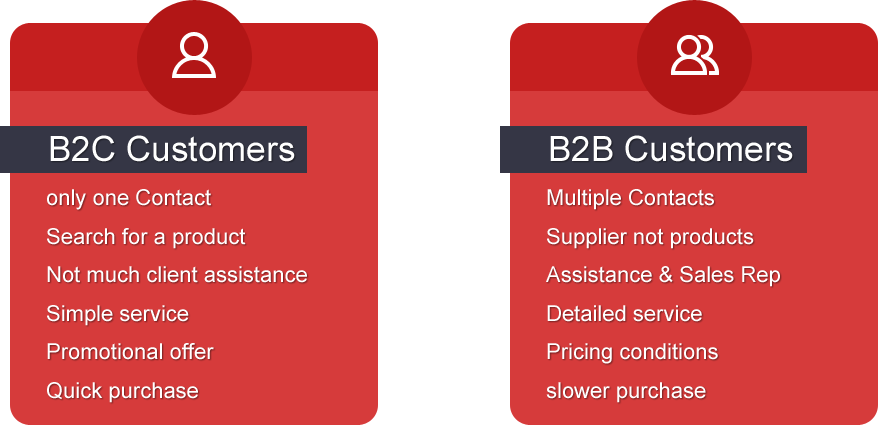
This is not the case in B2B model, the buyer is motivated by professional reasons, it’s their job to find a supplier. The primary focus for them is the bottom line rather than convenience. A single consumer has complete domain over their credit card, while a buyer might need approval from a committee or manager. Often, B2B platforms allow multiple accounts from a business, with a managerial account, to give final approval to a transaction after they are satisfied with the nuts and bolts of the deal.
2. Business Negotiation
Selling an outfit, a phone, a perfume bottle, you don’t need to negotiate too much with your customers, that’s the difference when applying a B2C ecommerce model because the terms already exist. It doesn’t matter whether you buy it or not, there are still other customers. But if you apply the B2B business model, you need to know how to negotiate skills, such as negotiating prices, quality of goods, the regime of payment, shipping, debt collection and so on.
3. Marketing Strategy
Unlike other e-commerce models, the B2B typically has a narrowly focused target market. For example, Airbus will seek to appeal to airline companies or defense departments and must appropriately tailor customer interaction. A B2C business will have a much broader demographic, targeted from young mothers to basketball players, perhaps casting a wider net.
This example clearly shows that there is no catch-all approach to e-commerce. When a buyer from a business sources products or services, we can assume he is knowledgeable about their benefits and will instead focus on the product’s features. Whereas a high-street consumer is more emotionally driven, the product’s benefits should be clearly displayed and easily digested on the platform.
4. Customer Relationship
A B2B company relies on long-term relationships with customers. Once happy with their suppliers, a business will often reorder multiple times. This means the platform needs to be tailored to make reordering as convenient as possible. While this should also be implemented in B2C platforms, the sporadic nature of transactions means relationships between the supplier and customer are more fleeting.
The long-term dynamics of a B2B relationship mean that businesses have a much greater lifetime value as customers compared to retail consumers. The vastly greater average price point of B2B vs. B2C e-commerce transactions reinforces this dynamic. While harder to convert into sales, a business will potentially order greater quantities at a higher price point for a longer period of time.
5. System Integration
Last but not least is system integration. For a successful online business, an e-commerce website needs to be fully integrated into the system of the business. However, if you do business with a B2C model, your website will not need to be integrated with too many complicated selling features, but vice versa. When you have a B2B model, you need to integrate a complicated trading system because you can’t always take good care of your big customers with automated systems like email, quotes, payment gateways, contracts, shipping, etc. Make sure the system always operates automatically without human supervision!
The Final Thought on Different Types of eCommerce Business Models
E-commerce businesses, in their different types of e-commerce, come fraught with a wide range of potential pitfalls, but by choosing the right approach for your business, these can be avoided.
Very little success comes from diving straight into a new business without proper research, planning, and, ideally, receiving expert guidance. It can be boiled down to three steps: choose a product, figure out your place in the market, and find the most efficient way to bring it to the customer’s doorstep.
Since 2013, fram^ has been making a name for itself as a reputable and trustworthy custom software development company, especially in eCommerce development services that serve all purposes. We cater to your every need in operating a business online, from consultancy and website building to post-deployment maintenance and support. Contact us today whether you have any questions or want to explore how we can help you!


